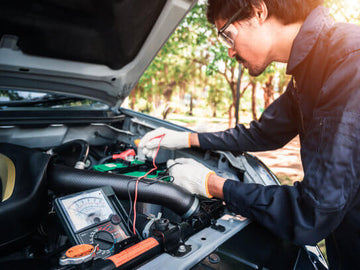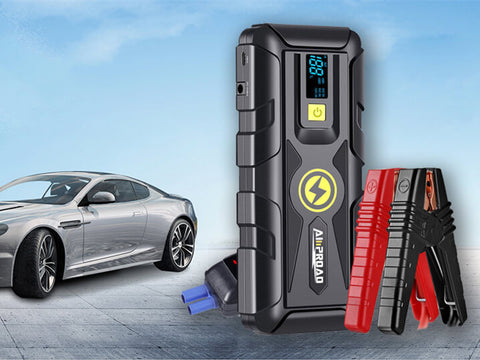
When it comes to ensuring your safety on the road, regularly testing your jump starter is paramount. A jump starter, also known as a car booster pack or portable jump battery booster, is a lifesaver in emergencies, providing the necessary power to jump-start a vehicle with a depleted battery. Understanding the importance of regular testing and maintenance can prevent unexpected failures and ensure your jump starter is ready when you need it most.
Before diving into the testing procedure, it's crucial to familiarize yourself with your jump starter and its components. Take the time to inspect it for any signs of damage or wear and ensure it's been stored properly. Safety should always come first, so make sure to follow safety precautions and handle the jump starter with care during testing. With these preparations in mind, you'll be ready to conduct a functional test and assess the performance of your jump starter effectively.
Importance of Regular Testing
Regular testing of your jump starter is essential to maintain its reliability and effectiveness, especially during critical situations. Understanding why regular testing is crucial can help you appreciate its importance in ensuring your safety on the road.
Why should you test your jump starter regularly?
Regular testing of your jump starter is crucial for several reasons, primarily ensuring reliability during emergencies. In times of need, such as when your vehicle's battery fails, having a functional jump starter can be a lifesaver. By testing your jump starter regularly, you can confirm that it's operational and ready to provide the necessary power to jump-start your vehicle when needed. Moreover, regular testing helps prevent unexpected failures by identifying any potential issues or malfunctions before they occur, allowing you to address them proactively.
Frequency of Testing
Determining how often to test your jump starter is essential for maintaining its effectiveness. The frequency of testing depends on various factors, including your usage patterns and manufacturer guidelines. It's generally recommended to test your jump starter every three to six months to ensure its readiness for use. However, if you frequently rely on your jump starter or live in extreme weather conditions, more frequent testing may be necessary. Following manufacturer recommendations for testing intervals and procedures can help ensure that your jump starter remains reliable and effective over time. Incorporating regular testing into your maintenance routine can prolong the lifespan of your jump starter and provide peace of mind knowing that it's ready to use in case of an emergency.
Preparing for Testing
Ensuring a safe testing environment is paramount before conducting any assessments on your jump starter. Begin by taking appropriate safety precautions, such as wearing protective gear and ensuring adequate ventilation in the testing area. Additionally, inspect the jump starter's exterior for any visible damage or wear that may compromise its functionality. Cracks, leaks, or signs of corrosion could indicate underlying issues that need to be addressed before testing. Properly handling the jump starter during testing is essential to prevent accidents and ensure accurate results.

Inspecting for Damage or Wear
Carefully inspect the jump starter for any signs of damage or wear that may affect its performance. Check the cables, clamps, and connectors for signs of fraying, corrosion, or loose connections. These issues can hinder the jump starter's ability to deliver power effectively and may pose safety hazards during use. Additionally, verify that the car booster pack has been stored properly and maintained according to manufacturer recommendations. Improper storage or neglecting maintenance tasks can lead to degradation of the jump starter's components and reduce its overall effectiveness.
Verifying Proper Storage and Maintenance
Proper storage and maintenance are critical for preserving the functionality and lifespan of your jump starter. Ensure that the jump starter has been stored in a cool, dry place away from extreme temperatures and moisture, which can degrade its components over time. Regularly inspect the jump starter for signs of wear or damage and perform any necessary maintenance tasks, such as cleaning the terminals or recharging the battery. Following manufacturer recommendations for storage and maintenance can help prolong the lifespan of your battery booster and ensure its reliability when needed most.
By taking these preparatory steps before testing your jump starter, you can ensure a safe and effective evaluation of its performance. Addressing any issues or concerns beforehand can help prevent accidents and ensure that your jump starter is ready to provide reliable power when you need it most.
Testing Procedure
When conducting a functional test of your jump starter, the first step is to ensure that it's connected to a compatible vehicle battery. This involves securely attaching the jumper cables to the appropriate terminals on both the jump starter and the vehicle battery, following the correct polarity to avoid damaging the electrical system. Once the connections are made, refer to the manufacturer's instructions for operating the jump starter. This may involve activating a power switch or button to initiate the charging process.
As the jump starter begins to supply power to the vehicle battery, it's essential to monitor the voltage output and observe the starting capabilities of the vehicle. Pay close attention to any fluctuations in voltage or unusual sounds during the starting process, as these may indicate underlying issues with either the jump starter or the vehicle's electrical system. So knowing how to boost a car properly is important, and if you encounter any abnormalities or issues during testing, such as a failure to start the vehicle or inadequate power output, it's important to address them promptly to prevent further damage or safety hazards.
Assessing Performance
Throughout the testing procedure, continually assess the performance of the jump starter to ensure its effectiveness in jump-starting a vehicle. This involves monitoring the voltage output to verify that it remains within the expected range and observing how quickly and smoothly the vehicle starts. A properly functioning portable battery booster should deliver consistent voltage output and enable the vehicle to start promptly without hesitation. If you notice any deviations from these expectations or encounter difficulties during testing, troubleshoot the issue promptly to determine the cause and take appropriate corrective actions.
By following these steps and guidelines during the testing procedure, you can effectively evaluate the performance and reliability of your jump starter. Regular testing ensures that your jump starter is ready to provide the necessary power to jump-start your vehicle in emergencies, providing peace of mind and safety on the road.
Interpreting Test Results
Upon completion of the jump starter test, it's essential to identify signs of a successful test. One indication is consistent voltage output throughout the testing process. A reliable jump starter should deliver a steady flow of power to the vehicle's battery, ensuring optimal performance during starting. Additionally, a successful test is characterized by a smooth and successful engine start-up, indicating that the jump starter effectively provided the necessary power to jump-start the vehicle.
While a successful test is reassuring, it's equally important to recognize potential issues that may arise during testing. One common issue to watch out for is low voltage output from the jump starter. A decrease in voltage output may indicate a malfunction or depletion of the jump starter's power source, compromising its ability to effectively jump-start the vehicle. Another potential issue is a failure to start the vehicle despite the jump starter's activation. This could signify underlying issues with either the jump starter or the vehicle's electrical system that need to be addressed promptly.
In addition to monitoring voltage output and starting capabilities, it's essential to remain vigilant for any unusual sounds or behaviors during testing. Strange noises or unexpected behaviors, such as sparks or smoke emanating from the jump starter, may indicate serious issues that require immediate attention. Ignoring these warning signs can lead to further damage or safety hazards, so it's crucial to address any abnormalities promptly.
By interpreting the test results accurately, you can gain valuable insights into the performance and reliability of your jump starter. Successful testing provides reassurance that your jump starter is ready to provide the necessary power to jump-start your vehicle in emergencies, ensuring your safety and peace of mind on the road. However, identifying and addressing potential issues promptly is equally important to maintain the effectiveness of your jump starter and prevent unexpected failures during critical situations.
Maintenance and Troubleshooting
Maintaining your jump starter is crucial for preserving its effectiveness and lifespan. Proper storage and charging practices play a significant role in maintaining the integrity of the jump starter's components. Store your jump starter in a cool, dry place away from extreme temperatures and moisture to prevent damage. Additionally, ensure that the jump starter is charged regularly to maintain its power capacity and readiness for use in emergencies.
Periodic inspection and cleaning of your jump starter are essential for identifying and addressing any potential issues before they escalate. Regularly inspect the cables, clamps, and connectors for signs of damage or wear, such as fraying or corrosion, and replace any damaged components promptly. Cleaning the terminals and connectors with a wire brush and terminal cleaner can help maintain proper electrical connections and prevent issues with power delivery.
When troubleshooting common issues with your jump starter, it's essential to address battery degradation promptly. Over time, the battery in your jump starter may degrade due to repeated charging cycles or improper storage practices. If you notice a decrease in the jump starter's power output or capacity, consider replacing the battery to restore its effectiveness.
Resolving connection problems is another common issue that may arise with jump starters. Ensure that the jumper cables are securely attached to the appropriate terminals on both the jump starter and the vehicle battery, following the correct polarity to avoid damaging the electrical system. If connection problems persist, check for loose or corroded connections and tighten or clean them as needed.
Seeking professional assistance for complex issues with your jump starter is advisable to ensure proper diagnosis and resolution. If you encounter persistent issues despite troubleshooting efforts, consult a qualified technician or electrician for assistance. They can perform diagnostic tests and identify any underlying issues with the jump starter or the vehicle's electrical system, providing appropriate solutions to restore functionality.
By following these maintenance and troubleshooting tips, you can ensure that your jump starter remains reliable and effective for jump-starting your vehicle in emergencies. Regular maintenance and prompt resolution of issues are essential for preserving the integrity of your jump starter and ensuring your safety on the road.
Best Practices
Understanding the best practices for maintaining your jump starter is crucial for maximizing its lifespan and ensuring its reliability during emergencies.
Tips for Maximizing Jump Starter Lifespan
Best Practices Following manufacturer recommendations is key to maximizing the lifespan of your jump starter. Adhering to guidelines for charging frequency, storage conditions, and maintenance tasks can help preserve the integrity of the jump starter's components and prolong its effectiveness. Storing your jump starter in a cool, dry place away from extreme temperatures and moisture is essential for preventing damage and degradation. Additionally, avoid overcharging the jump starter, as this can shorten its lifespan and reduce its overall effectiveness over time.
Regular Testing and Proactive Maintenance Are Essential
Regular testing and maintenance are essential for ensuring the reliability of your jump starter during emergencies. By incorporating regular testing into your maintenance routine and following best practices for storage and charging, you can prolong the lifespan of your jump starter and ensure that it's ready to provide the necessary power to jump-start your vehicle when needed. Additionally, proactive maintenance can help identify and address any potential issues before they escalate, minimizing the risk of unexpected failures. By prioritizing the care and maintenance of your jump starter, you can enjoy peace of mind knowing that you're prepared for any roadside emergencies that may arise.



